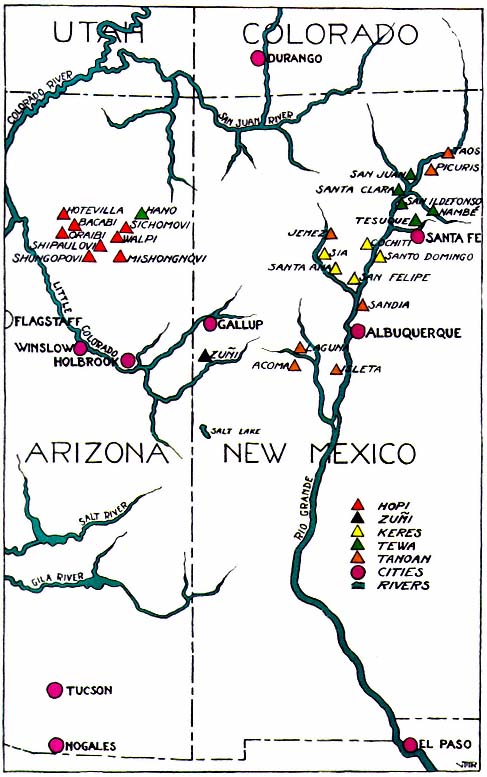Location of Pueblos
Hopi.
—In the extreme western end of the Pueblo country, in northern Arizona, the Hopi villages are perched on spurs and promontories with precipitous walls and limited level spaces, seven thousand feet above sea level. Situated much as they were when first seen by the Spaniards, they are divided geographically into three groups. To the east on First Mesa are the towns of Walpi and Sichomovi and the Tewa town of Hano; on the middle or Second Mesa are Mishongnovi, Shipaulovi, and Shungopovi; and to the west on Third Mesa are Oraibi and its two offsprings, Hotevilla and Bacabi. Although a growth of piñon and juniper on the

Plate 1.
Zuñi woman in traditional dress.
mesa indicates rainfall sufficient for crops, the declivity of the land makes drainage so rapid that the rains are of little value. Nevertheless, there are springs and natural underground reservoirs which, with seepage and slow drainage, make agriculture possible in the valleys and washes.
Zuñi.
—To the south and east, on the desert of western New Mexico, is a strip of land roughly following the course of the Zuñi River from its headwaters near the Continental Divide to a point near the Arizona border. From rugged forested mountains slashed by canyons there opens up to the south and west a wide, flat valley some six thousand feet above sea level. Through it the Zuñi River floods or trickles. Melting snow in the mountains or a sudden summer storm may within a few minutes transform the stream into a raging torrent which, subsiding, leaves silt and mud on its otherwise sandy banks. In the bordering hillsides to the east are perpetual springs of clear water. On a rise of ground west of the river, and in the center of the broad valley, is the principal town of Zuñi. It is surrounded by sandy flats on which is an indigenous growth of sage, greasewood, yucca, and small cacti. With care, the fields can be flooded and cultivated to raise the crops which are so essential to the life of these people. On near-by mesa, cliff, and plain are the ruins of former villages, the study of which proves that the "Seven Cities of Cibola" which inspired the Coronado expedition of 1540 did actually exist—in whole or in part.[3] Today Zuñi is the sole urban unit, with the exception of four small summer settlements for the cultivation of distant fields.
Rio Grande.
—The remaining pueblos are found on the eastern slope, across the Continental Divide. They are grouped along the Rio Grande and its tributaries, all of which flow southward from the wooded and canyoned foothills of a three-sided watershed. To the west are the Jemez Mountains; to the north, the Sangre de Cristo; and to the east, the Sandia and Manzano ranges. Here, where the low-banked streams are fringed with cottonwood and willow, lie broad flats of cultivable land which provide ample agricultural areas for the needs of the adjacent villagers. With
an average elevation of fifty-five hundred to six thousand feet, these towns vary little in altitude from the pueblos farther west, but because of their accessibility, their proximity to the plains on the east, and their own diversified but closely related cultures these eastern groups present a complicated problem.
In order to understand the cultural relationships more clearly, it will be necessary to examine the linguistic affiliations.[*] These most definitely divide the villages.
The Hopi, of the west, are of Shoshonean stock and use a dialect of that branch of the Uto-Aztecan linguistic family. Zuñi has an individual language. The eastern groups, however, are of two linguistic units, the Keresan and the Tanoan. Because of their proximity to each other and the gradual infusion of outside influences it is impossible to classify with the linguistic affiliation the resultant habits and practices.
First, there are the seven Keresan-speaking pueblos:
Acoma.
—A fortified town on the top of a precipitous mesa four hundred feet above the surrounding plain, on the southernmost edge of the Pueblo span, close to Zuñi.
Laguna.
—Somewhat to the north and east, on the high north bank of the San José River, but nearer Acoma than any of the other pueblos.
San Felipe.
—On the west bank of the Rio Grande, near the mouth of the Jemez River.
Santa Ana and Sia.
—Both on the north bank of the Jemez River, respectively twelve and twenty miles from its mouth.
Santo Domingo.
—On the east bank.
Cochiti.
—On the west bank.
Both Santo Domingo and Cochiti lie farther up the Rio Grande Valley. Then there are the eight Tanoan pueblos, the sites of which, curiously enough, almost enclose the Rio Grande Keresans, as may be seen by the map on the opposite page.
* See Appendix, p. 235.

Isleta and Sandia.
—On the west and east banks, respectively, situated far to the south of the Keresan group on the Rio Grande. These pueblos form the southern division of the Tigua.
Jemez.
—On the Jemez River above Santa Ana and Sia and below the mouth of San Diego Canyon.
Nambé and Tesuque.
—To the east on two small tributaries, the Nambé and Tesuque rivers, a few miles north of Santa Fe.
San Ildefonso.
—On the east bank of the Rio Grande.
Santa Clara.
—On the west bank.
San Juan.
—Farther north on the east bank.
The five last named form a group of towns on the sand dunes and plains occupied by the Tewa division of the Tanoan stock. The Hano, of the First Mesa of the Hopi, are emigrants from these.[4]
Finally there are:
Picuris.
—At the foot of the Picuris Mountains.
Taos.
—The most northern of the pueblos, on both sides of the Taos River.
These two pueblos form the northern division of the Tigua.